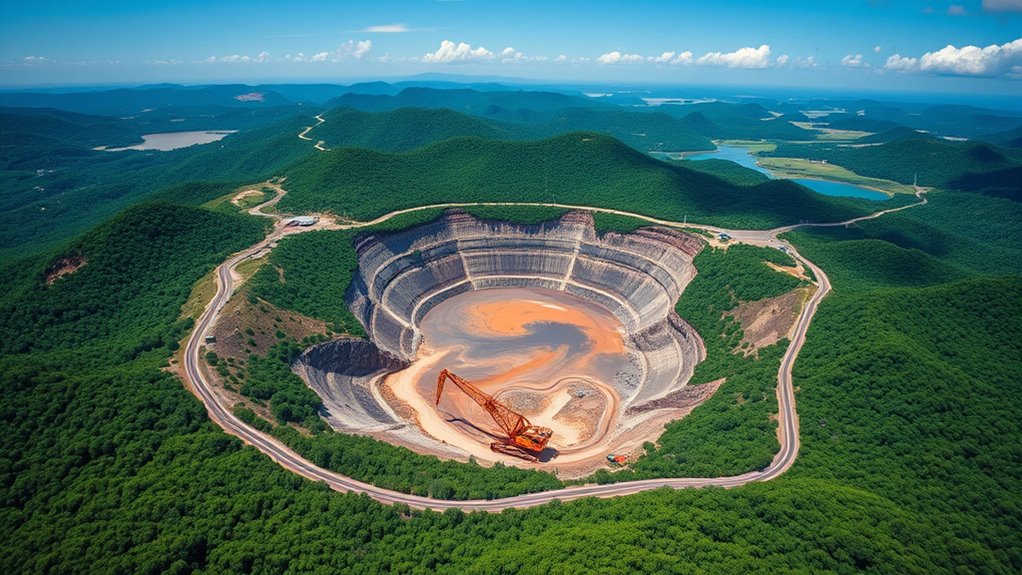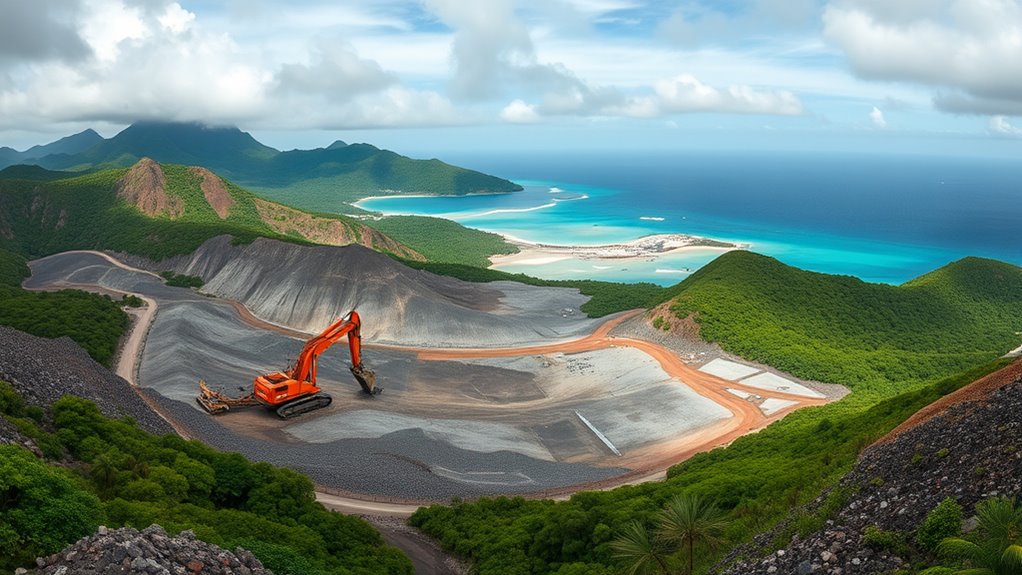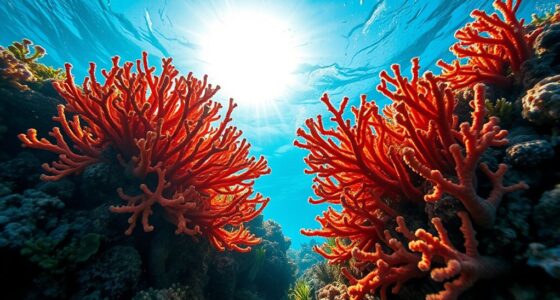The nickel boom in New Caledonia brings economic growth and global investment, but it also risks environmental damage, including deforestation, soil erosion, and water pollution. Indigenous communities are actively advocating for land rights and cultural preservation amidst these changes. To truly balance economy and ecology, sustainable practices and strong regulations are essential, ensuring long-term health for both nature and local people. Keep exploring to discover how stakeholders are working to find this vital balance.
Key Takeaways
- Sustainable mining practices are essential to mitigate environmental damage from rapid nickel industry expansion.
- Engaging Indigenous communities ensures their land rights and cultural values are respected during economic development.
- Proper regulation and land rehabilitation can balance economic growth with ecological preservation.
- Transparency and responsible stakeholder involvement promote sustainable development in nickel-rich regions.
- Long-term environmental health depends on managing deforestation, soil erosion, and water pollution caused by mining activities.

New Caledonia is experiencing a remarkable nickel boom that’s transforming its economy and attracting global attention. As you watch this rapid growth unfold, it’s essential to consider the environmental impacts that come with such a booming industry. Nickel mining, while lucrative, often leads to deforestation, soil erosion, and water pollution. You might notice landscapes changing dramatically, with large areas cleared for mining operations, disrupting local ecosystems. This environmental toll raises concerns about the long-term health of the region’s biodiversity and the sustainability of its natural resources. You need to understand that without proper management, the riches from nickel extraction could come at the expense of the environment you cherish.
At the same time, this economic surge directly affects the Indigenous communities of New Caledonia. These communities have long-standing ties to their land, and their rights are central to the ongoing development debates. You should recognize that many Indigenous groups, especially the Kanak people, are fighting to protect their ancestral lands from being overtaken by mining projects. Their concerns go beyond environmental issues; they include cultural preservation, land rights, and social justice. You might see protests or negotiations happening, as Indigenous leaders push for greater participation in decision-making processes. It’s essential to balance economic benefits with respecting Indigenous rights, ensuring that local communities are not marginalized or displaced. Additionally, understanding the importance of environmental stewardship can help foster more sustainable development practices that benefit both the economy and the planet.
If you’re involved or concerned about the future of New Caledonia, you’ll want to follow how authorities and companies address these challenges. Responsible mining practices can help mitigate environmental impacts, such as enforcing stricter regulations on waste management and land rehabilitation. Meanwhile, engaging Indigenous communities as partners rather than mere stakeholders can lead to more equitable outcomes. You might advocate for policies that prioritize environmental stewardship and uphold Indigenous land rights, recognizing that economic gains shouldn’t come at the cost of cultural identity or ecological stability.
As the nickel industry grows, your role could be essential in promoting transparency and sustainable practices. You can support organizations and initiatives that aim to protect New Caledonia’s environment and Indigenous heritage. Ultimately, the goal is to find a way for the region to benefit economically while preserving its natural beauty and respecting its people’s rights. The challenge lies in balancing these priorities, so that New Caledonia’s nickel boom becomes a force for positive change rather than irreversible harm.
Frequently Asked Questions
How Does Nickel Mining Impact Local Indigenous Communities?
Nickel mining can greatly impact your indigenous communities by threatening land rights and cultural preservation. As mining expands, it may encroach on Indigenous land, risking displacement and loss of sacred sites. You might face challenges in maintaining your cultural traditions tied to the land. It’s essential to guarantee that your Indigenous land rights are respected and that cultural preservation efforts are prioritized, so your community’s heritage remains intact amidst economic development.
What Renewable Energy Sources Are Used in Nickel Processing?
Imagine bright sunlight reflecting off vast solar panels and wind turbines spinning gracefully against the sky. In nickel processing, you’ll find solar power harnessing the sun’s energy to reduce reliance on fossil fuels. Wind turbines, standing tall and steady, capture breezes to generate clean electricity. These renewable sources help make nickel extraction more sustainable while protecting the environment, allowing the land and communities to thrive alongside this essential industry.
Are There International Regulations Overseeing Nickel Mining in New Caledonia?
You should know that international protocols guide mining oversight in many regions, including New Caledonia. While specific regulations vary, these protocols aim to guarantee sustainable practices and environmental protection. In New Caledonia, local authorities and international organizations often collaborate to oversee nickel mining activities, balancing economic benefits with ecological concerns. So, although there isn’t a single global regulation, international standards influence how mining is managed in the area.
How Is Water Pollution From Mining Activities Being Managed?
You’re curious about how water pollution from mining activities is managed. You’ll find that effective water treatment and pollution control measures are implemented to reduce environmental impact. Mining companies often treat wastewater before discharge, minimizing harmful pollutants. Regular monitoring guarantees compliance with regulations, and some areas enforce strict pollution controls. These steps help protect local water sources, demonstrating a commitment to sustainable mining practices that balance economic benefits with ecological preservation.
What Are the Long-Term Economic Prospects Beyond Nickel?
Imagine you’re steering a ship through shifting global market trends; diversification strategies become your compass beyond nickel. Long-term prospects depend on expanding into tourism, agriculture, and renewable energy. You’ll need to adapt to changing economic tides, just like charting uncharted waters. By embracing innovation and sustainable growth, you can secure a resilient economy that’s less reliant on nickel, ensuring New Caledonia’s prosperity endures well beyond the current boom.
Conclusion
As you navigate New Caledonia’s shimmering nickel boom, remember it’s like walking a tightrope stretched over a shimmering canyon. The riches promise progress, but the ecological echoes warn of a fragile balance. If you focus only on the gleam, you risk losing the vibrant heartbeat of the island’s soul. To truly thrive, you must weave sustainability into the fabric of growth, ensuring the island’s future isn’t just a fleeting sparkle but a lasting glow.









